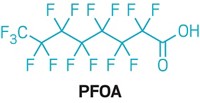Advertisement
Grab your lab coat. Let's get started
Welcome!
Welcome!
Create an account below to get 6 C&EN articles per month, receive newsletters and more - all free.
It seems this is your first time logging in online. Please enter the following information to continue.
As an ACS member you automatically get access to this site. All we need is few more details to create your reading experience.
Not you? Sign in with a different account.
Not you? Sign in with a different account.
ERROR 1
ERROR 1
ERROR 2
ERROR 2
ERROR 2
ERROR 2
ERROR 2
Password and Confirm password must match.
If you have an ACS member number, please enter it here so we can link this account to your membership. (optional)
ERROR 2
ACS values your privacy. By submitting your information, you are gaining access to C&EN and subscribing to our weekly newsletter. We use the information you provide to make your reading experience better, and we will never sell your data to third party members.
Persistent Pollutants
US EPA sets health advisory limits for 6 PFAS
For PFOA and PFOS, limit is less than a part per trillion
by Cheryl Hogue
June 15, 2022
| A version of this story appeared in
Volume 100, Issue 22

Levels of several toxic per- and polyfluoroalkyl substances (PFAS) (PFAS) in drinking water should be extremely low to protect public health, the US Environmental Protection Agency says. PFAS are a family of synthetic compounds that resist degradation under ambient and extreme conditions.
On June 15, the EPA tightened its lifetime health advisory levels for two PFAS that are globally widespread contaminants in drinking water, perfluorooctanoic acid (PFOA) and perfluorooctanesulfonic acid (PFOS). For PFOA, the recommendation is 0.004 part per trillion (ppt) and for PFOS, 0.02 ppt. These levels are dramatically more stringent than the 70 ppt that the EPA recommended in 2016 for the two compounds.
The agency’s new advisory levels aren’t requirements that drinking water suppliers must meet. The EPA only recommends that utilities notify customers when concentrations exceed the limit.
But they set the stage for further EPA action. The agency plans to propose mandatory drinking water limits for PFOA and PFOS later this year. The two substances, no longer made in the US, were used in firefighting foams and industrial processes for decades.
In addition, the EPA rolled out first-ever health advisory levels for two PFAS associated with Chemours’s GenX process for manufacturing fluoropolymers. They are hexafluoropropylene oxide dimer acid (HFPO-DA) and its ammonium salt. The recommend limit for each of these chemicals is 10 ppt, the EPA says.
GenX substances taint drinking water supplies in southeastern North Carolina downstream of a Chemours plant and wells near a Chemours facility in West Virginia. E.I. du Pont de Nemours and Company owned both plants and developed the GenX process to replace the use of PFOA in fluoropolymer production. It spun off that part of the business as Chemours in 2015.
In an emailed statement, Chemours says the underlying scientific analysis that the EPA relied on to set the advisory level is “fundamentally flawed.” The company says it’s evaluating its next steps, including possible legal action.
Also, the EPA set a health advisory level of 2,000 ppt each for perfluorobutane sulfonic acid (PFBS) and potassium perfluorobutane sulfonate. Manufacturer 3M introduced these chemicals as a less toxic replacement for PFOS for use as a surfactant and to make water- and stain-resistant coatings.
3M did not respond to a request for comment before C&EN’s deadline.
“People on the front-lines of PFAS contamination have suffered for far too long,” EPA Administrator Michael S. Regan says in a statement announcing the new advisory levels. He notes that the bipartisan infrastructure law passed by Congress last year includes $1 billion to help affected communities reduce PFAS and other contaminants in their drinking water. Regan served as the top environmental regulator in North Carolina when GenX-related PFAS were discovered in drinking water supplies there.
The American Chemistry Council, a chemical industry trade group, says in an emailed statement that although the EPA’s advisory levels are not legally binding, “they will have sweeping implications for policies at the state and federal level.” The group claims that in the process of setting the levels, the EPA failed to follow agency scientific integrity practices.
Environmental and health advocates welcomed the new health advisories. But they say the stringent new limits indicate the EPA needs to do more to protect the public from exposure to toxic PFAS. They are calling for regulation of these chemicals in air emissions, discharges to water, and waste to control the spread of PFAS contamination.
The PFAS health advisories “should set off alarm bells for consumers and regulators,” Melanie Benesh, legislative attorney for the Environmental Working Group, says in a statement. “These proposed advisory levels demonstrate that we must move much faster to dramatically reduce exposures to these toxic chemicals.”
According to the EPA, exposure to PFOA or PFOS is associated with suppression of the human body’s immune response to vaccines, harm to the cardiovascular system, and interference with the development of fetuses and children. Studies in laboratory animals link the GenX chemicals to adverse kidney, liver, immune system, and developmental effects. And PFBS and its related potassium sulfonate lowered thyroid hormone levels in laboratory animals and had harmful effects on their reproductive organs, kidneys, and developing fetuses, the agency says.





Join the conversation
Contact the reporter
Submit a Letter to the Editor for publication
Engage with us on Twitter